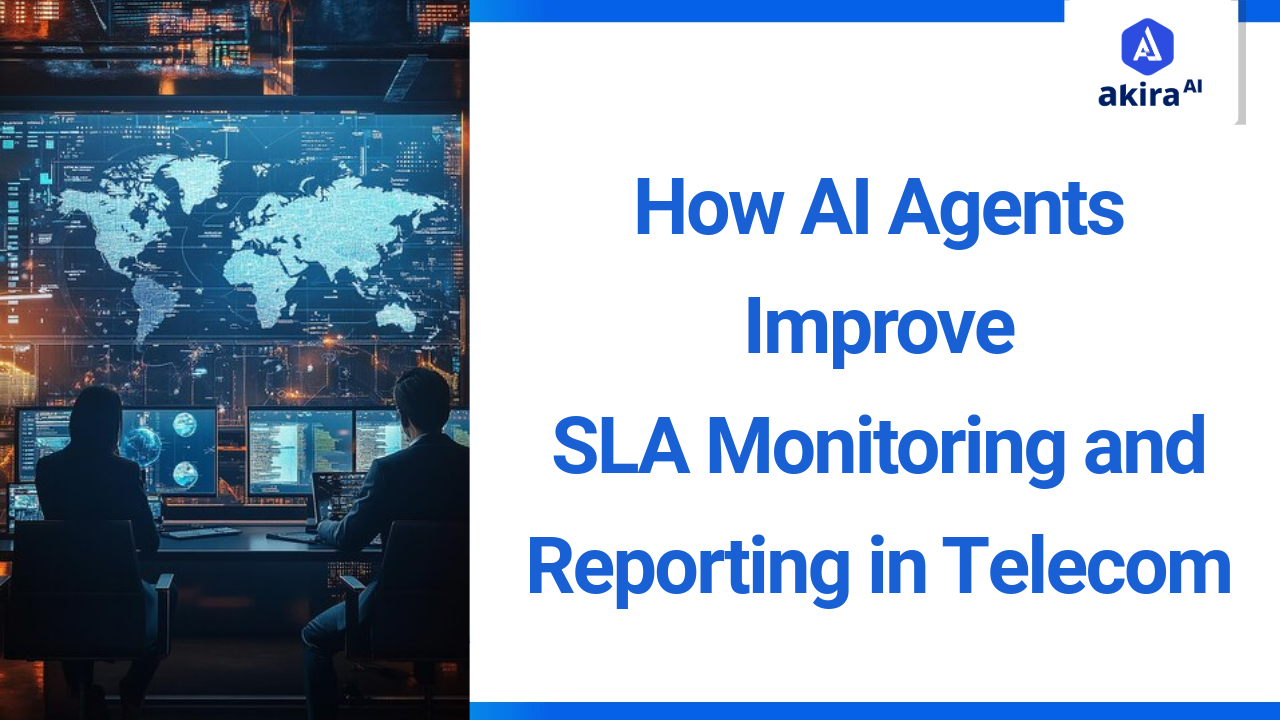"Data is the new oil." This statement by Clive Humby reflects the critical importance of data in modern telecommunications. User requirements are growing continuously, meaning that capacity management of the networks is critical in order to ensure quality of service delivery. AI agents have turned into a necessity for telecom operators because they make it possible to analyze big data. Understanding the implications of AI in telecom network planning is crucial for stakeholders looking to navigate the complexities of this rapidly evolving industry. In this blog, we will discuss how these intelligent systems revolutionize network management's optimum strategies and overall productivity.
What is Network Capacity Planning and Optimization in Telecom?
Network capacity planning in telecom is about determining the existing and expected demand to be able to continue providing service through the network framework without compromising the quality of the network. This process entails consideration of factors such as traffic flow, user interactions, and the technology adopted in order to establish what amount of bandwidth, equipment, and resources is necessary to give a customer the best network connection. It is all about satisfying current requirements while being prepared for future growth and development, thus enabling telecom operators to stay relevant in a very dynamic market.
A Brief Overview of Network Capacity Planning and Optimization in Telecom
The landscape of network capacity planning and optimization in telecom has long been characterized by reliance on historical data and manual intervention. Traditionally, operators would gather usage statistics and employ statistical models to forecast future needs, often resulting in over-provisioning or under-provisioning resources.
With the emergence of AI in network optimization, telecom providers are now equipped with powerful tools that transform these traditional practices. AI agents use sophisticated algorithms to analyze real-time data streams, enabling dynamic decision-making and aligning resources with actual demand. These agents enable the optimization of network resources through the use of predictive analytics with the aim of trapping future loads. This replaces a reactive approach to network management with a proactive one, which provides a better response mechanism for network functions.
Traditional vs. Agentic AI-based Network Capacity Planning and Optimization
|
Aspect |
Traditional Approach |
Agentic AI-Based Approach |
|
Data Analysis |
Manual data analysis is often slow and prone to errors |
Real-time data analysis using AI algorithms |
|
Forecasting |
Historical data-based forecasting |
Predictive analytics for accurate demand forecasting |
|
Response Time |
Delayed response to network issues |
Immediate adjustments through autonomous agentic AI systems |
|
Resource Utilization |
Risk of over/under-provisioning |
Optimized resource allocation with load balancing |
|
Decision-Making |
Human-dependent decision-making |
Automated decisions via multi-agent systems |
|
Adaptability |
Limited adaptability to sudden changes |
High adaptability with continuous learning capabilities |
|
Operational Costs |
Higher operational costs due to inefficiencies |
Lower operational costs through optimized resource use |
Akira AI Multi-agent in Action
Akira AI employs a sophisticated multi-agent system that provides an increased network capacity improvement setup. The agents utilized by Akira AI include:
-
Monitoring Agent: This agent continuously tracks network performance metrics, such as bandwidth usage, latency, and error rates. Gathering real-time data provides insights into current network conditions, allowing for immediate corrective actions.
-
Forecasting Agent: Utilizing historical data and predictive analytics, this agent forecasts future traffic demands. It analyzes trends and user behavior to anticipate peak times and resource needs, enabling proactive management.
-
Resource Allocation Agent: This agent is responsible for dynamically adjusting bandwidth and other resources based on real-time data from the monitoring agent and predictions from the forecasting agent.
-
Load Balancing Agent: This agent controls the flow of traffic in the network segments so as to avoid congestion and, at the same time, provide an excellent service. It contains high-traffic redirection mechanisms to avoid overloading at certain intervals.
-
Anomaly Detection Agent: This agent analyzes the traffic pattern of the data network to identify abnormalities of a security concern or a sign of an operations problem. An early-stage alert ensures that solutions are employed to prevent the invasion of the network integrity.
-
Customer Experience Agent: This agent tracks customer experience and the quality of service to offer valuable information to telecom operators that can improve user experience.
Use Cases of Network Capacity Planning and Optimization
-
Dynamic Resource Allocation: Telecom operators can use AI in network optimization to actively control resources according to user demand. This enhances service quality and improves customer satisfaction by ensuring minimal lag or downtime.
-
Predictive Maintenance: With the ability to anticipate potential issues before they occur, these agents facilitate proactive maintenance strategies. This reduces downtime and maintenance costs while improving overall network reliability.
-
Traffic Management: Network traffic is dissected by agents with the purpose of enhancing or fine-tuning the patterns of data transmission. Thus, efficient traffic management enables the telecom providers to maintain the required performance during peak usage time – which is paramount for telecom service quality.
-
Fraud Detection: These agents can track deviations in average network usage, for example, erratic behavior which might signify fraud. Preventive measures for risk identification include early detection mechanisms that greatly reduce risk and improve security while preventing loss of revenue.
-
Network Expansion Planning: By analyzing growth patterns and projected demand, intelligent agents help operators determine whether the creation of a new network or the improvement of an existing one is reasonable. They make sure that the resources being used fit the needs that are genuine and feasible, which is vital for maintaining service quality.
-
Customer Behavior Analysis: Analysis of user behavior is crucial in the context of telecommunication networks’ efficiency. Such agents can also get to understand how the customers are using their products and tailor services and even promotions, hence improving customer retention.
-
Self-Organizing Networks (SON): Integrating self-organizing networks allows for automated adjustments in real-time, improving operational efficiency and reducing manual oversight.
Operational Benefits of Network Capacity Planning and Optimization
-
Enhanced Productivity: When used to perform repetitive tasks, such agents can increase efficiency by up to 30%. This shift can help telecom providers to optimize their human resources in a better manner.
-
Lower Operational Costs: These agents help strip down telecommunication operations costs while helping telecom operators direct spare capital to other improvements and adaptations.
-
Improved Load Balancing: Such agents enhance load balancing across the network, ensuring optimal performance and minimizing congestion. This results in improved user satisfaction and decreased incidences of low quality of service.
-
Scalability: The ability to scale operations quickly in response to demand fluctuations is a crucial advantage of utilizing autonomous agents. This agility ensures that telecom operators can meet customer needs without significant delays or resource wastage.
-
Informed Decision-Making: With access to real-time data and predictive analytics, these agents enable more informed decision-making. This leads to better planning and strategy formulation, ensuring that resources are used where they are needed most.
Technologies Transforming in Network Capacity Planning and Optimization
-
Machine Learning: The application of machine learning algorithms enables telecom operators to improve the company’s predictive analysis and demand forecasting efficiency. Such algorithms can be made dynamic and increasingly accurate as planning and capacity data accumulate and new information enters the system.
-
Cloud Computing: Cloud technology provides the scalability and flexibility needed for modern telecom operations. Operators can adapt to fluctuating demands using cloud-based solutions without incurring significant upfront costs, enabling efficient network capacity planning.
-
5G Technology: The rollout of 5G networks introduces challenges and opportunities. AI agents will be crucial in managing the complexities of higher data speeds and increased user demands, ensuring that networks are optimized for next-generation applications.
-
Edge Computing: By processing data closer to the source, edge computing reduces latency and enhances responsiveness. It helps to improve telecom network optimization in real time so the operators can be in a position to deliver better service quality.
-
Network Function Virtualization (NFV): NFV decouples network functions from hardware, allowing for more agile and efficient network management. This flexibility supports dynamic resource allocation and improves overall service delivery.
Future Trends of Network Capacity Planning and Optimization
-
Advancements in AI Technology: Ongoing improvements in AI and machine learning will enhance the capabilities of AI agents, leading to more sophisticated and effective network management solutions. Telecom operators will be in a favorable position to benefit from the advances in these technologies in terms of enhancing the predictive analytics and the decisions that are involved.
-
Rise of Autonomous Systems: More telecom operators will adopt autonomous agentic AI systems, reducing reliance on human intervention for routine tasks. This shift will increase efficiency and allow human resources to focus on strategic initiatives rather than daily operations.
-
Synergy with 5G Infrastructure: As 5G networks expand, autonomous agents will be critical in managing the complexities associated with higher-speed connectivity and increased user demands. They will ensure that networks remain responsive and capable of handling the surge in data traffic.
-
Strengthening Cybersecurity Measures: With the rising importance of network security, such agents will increasingly be utilized to identify and mitigate potential security threats. This proactive approach will enhance overall network integrity and protect sensitive user data.
-
Personalized Customer Experiences: Intelligent agents will enable deeper insights into user behavior, allowing telecom providers to tailor services and promotions more effectively. This level of personalization will improve customer satisfaction and retention.
Conclusion: AI Agents for Network Capacity Planning and Optimization
So, the next time you enjoy a seamless call or fast internet, remember the role of AI agents behind the scenes! These agents are not just helping operators manage their networks; they’re also redefining the standards for service quality in the telecom industry. As these technologies continue to evolve, we can look forward to even more exciting innovations that will enhance our daily experiences. AI in network capacity planning is a game-changer, empowering operators to tackle the challenges of today and tomorrow. By using these intelligent systems, telecom companies can be sure that they are equipped to meet our ever-growing demands. It’s an exciting time in the world of telecom, and the future looks brighter than ever.
Read More


